|
|
|
Published
on 17
Dec 2013
|
All rights reserved.
|
|
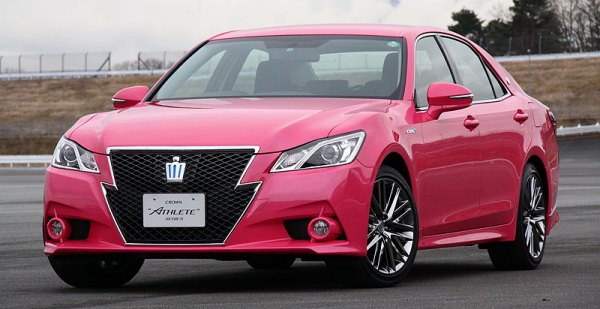
Crown Athlete
|
Whenever we mention
Toyota Crown, we would think of a conservative near-luxury saloon
serving mostly company executives of 50 to 60 years old. So what would
you think about the pink car with a funky grille pictured above? It is
not a modified Crown but a stock new one. It signals Toyota's desire to
change the 58-year-old nameplate. Why the need for big changes? Falling
sales, of course. 20 years ago the Crown was still enjoying an annual
domestic sales of 200,000 units. Last year it fell to just over 30,000,
probably below the breakeven point. The fall is just as dramatic as the
sales of Commodore and Falcon in Australia. On the one hand it shows
the dead-end road for domestic-bounded cars, on the other hand it tells
us even a reputed nameplate has to adapt to the changing market
trends.
Toyota observed 2 market trends. The first one is the migration towards
sportier cars. This is not only evident on BMW, Mercedes and Audi but
also on the Crown itself – introduced in 1999, the Crown Athlete model
has been increasing sales gradually and now it outnumbers the Crown
Royal. Therefore, Crown Athlete is to take a center stage this time in
the making of the 14th generation. Another trend is the prosperity of
hybrid models in the domestic market. The domestic sales chart is now
dominated by Prius, Aqua and whatever models with hybrid offerings. The
new Crown has to do more on the hybrid side.
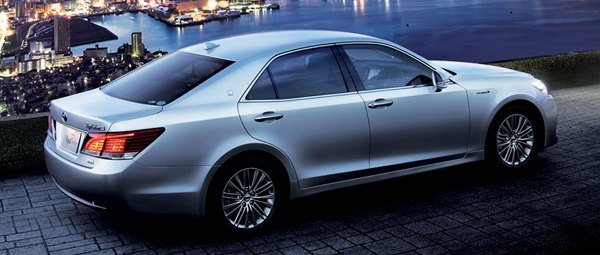
|
What the new generation Crown cannot change is the platform on which it
is based. Sharing platform with Lexus GS, IS and Toyota Mark X, it is
practically a light evolution from the last generation. Its 2850 mm
wheelbase
is kept, while outer dimensions vary just a tiny bit (+25 mm length, +5
mm width and -20 mm height). Toyota claimed more spot welds improve
chassis rigidity but didn't say how much, so don't expect it to match
the full model makeover of its German rivals. The suspension remain
double-wishbone up front and multi-link at the rear, backed by AVS
adaptive damping. Detailed changes to the suspension improve ride and
handling though. The rear suspension now employs control arms with
C-shape cross section to reduce unsprung weight. The front tie rods and
rear toe-control arms are offset to improve cornering stability.
Improved monotube dampers also improve ride quality, claimed Toyota.
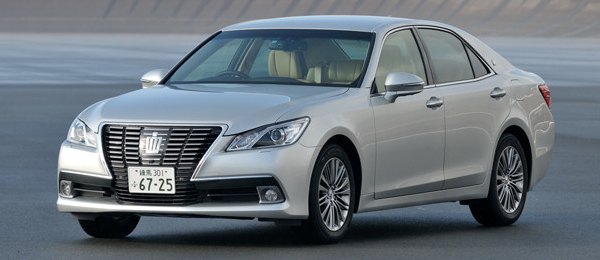
Crown Royal
|
The new body shape is slightly sleeker and its lines slightly crisper
than the old car's, although it still looks more conventional than its
Western rivals as well as its Lexus siblings. More radical is the
massive front grille. There are 3 versions actually – on Athlete model,
the grille is shaped like a crown; on Royal, it is merged with the
lower grille; on the range-topper Majesta, it employs vertical elements
like a waterfall. However, none of them can be described as beauty. Its
designers might see a big grille as an identity of luxury, but it
doesn't mean the desired effect can be achieved by arbitrary designs,
as many Chinese car makers do. If you look at Audi's single-frame
grille, it took a lot of experiments and polishing before resulting in
the final design. Ditto the prominent grille of Rolls-Royce, which has
been evolving gradually throughout its long history. The Crown's
grilles just look weird and
designed out of a poor taste, especially the Royal.
If you can overcome its controversial grille, the Athlete model is the
one to have. Its front bumper intakes, fog lights and aero kits look
sportier and more stylish. The same goes for the larger alloy wheels,
wider and lower profile tires it employs. Therefore it is expected to
account for more than half the sales. At the other end, the Majesta
will continue to be a rarity. Targeting at company bosses – it is the
domestic equivalent of Lexus LS – it has a 75 mm longer wheelbase than
others, providing more room for the boss to stretch his legs.
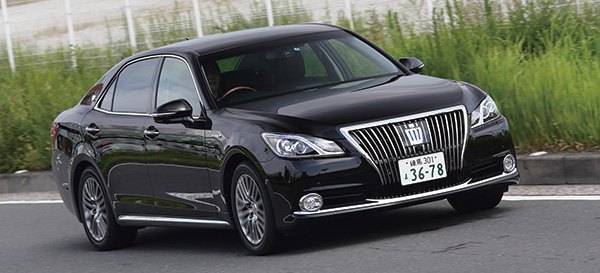
Crown Majesta
|
Speaking of interior, the new dashboard design looks more functional
than artistic, but the materials and build quality has received a
noticeable upgrade like the rest of the industry. Ergonomics is
improved by mounting the infotainment touch screen higher on the
console thus keeps your sight closer to the road ahead, although the
software user interface is too complicated. A few more physical buttons
for controlling regularly used functions would be welcomed. The main
instruments still employ hardware dials, skipping the TFT
reconfigurable display that many new rivals have adopted. This shows
the old-fashion side of the Crown. However, the sound insulation is
excellent, keeping the cabin quiet on the run. Rear passengers on the
standard wheelbase model enjoys 20 mm boost of legroom, thanks to the
thinner front seat back. The 552-liter boot is generous, too.
From enthusiast point of view, we would have liked to see the new
Crown, especially the Athlete, to be faster yet more frugal like its
European counterparts. However, this is not the case. One reason is the
budget cap, which means all powertrains have to be carried over from
either the old car or its Lexus siblings. Another reason is that the
new car is more oriented to fuel economy.
As before, the entry-level engine is a 2.5-liter direct-injected V6
(now rated slightly lower at 203 hp), while reserving for the
performance-oriented Athlete is a 315 hp 3.5-liter V6 with D4-S dual
injection and 8-speed automatic transmission. The mid-range 3.0-liter
V6 has been substituted by a new hybrid powertrain taken straight from
Lexus IS/GS300h. It consists of a 2.5-liter DI Atkinson-cycle
four-cylinder engine and electric motors, producing a system output of
220 hp. The last generation Crown also had a hybrid model, but that one
employed a 3.5 V6 thus you can see the new hybrid is easily cheaper to
buy and a lot more frugal to run. Expect the new hybrid will account
for 60 percent of all sales. Both Athlete and Royal can be equipped
with this powertrain.
The 3.5 V6 hybrid hasn't died though. It now lives under the bonnet of
Majesta, replacing the old car's 4.6-liter V8. The system output of 343
hp should keep its performance close to before while saving a great
deal of petrol.
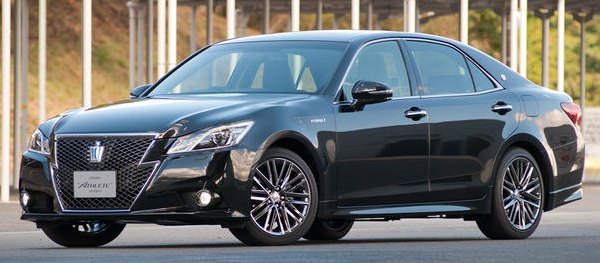
Crown Athlete
|
On the road, the performance the Mk14 offers is very similar to the
Lexus GS with equivalent engines, but the ride and handling depends
very much on models. Naturally, the Royal and Majesta are
comfort-oriented, with very soft suspension and light steering setting.
They roll a lot and understeer early in corners. The grip offered by
the modest tires is mediocre. The overassisted steering offers little
feel. In other words, no fun to drive these cars at all. They are
suitable to only those want to drive relaxingly, or even better, those
sitting at the back. In contrast, the Athlete with its firmer
suspension, heavier steering and grippier rubbers is much better suited
to keen drivers. It feels almost like another car. However, the lack of
extensive road test on Nurburgring etc. during its development means
its driver appeal could fall off quickly when the road gets more
challenging and the pace is increased, although this is harder to prove
on perfect Japanese roads.
Anyway, the future of Crown remains uncertain. If the new hybrid model
is proved to be popular, it could sustain longer. But in longer term
globalization seems to be inevitable, especially when the domestic
market for large cars is set to shrink further. Now the Crown already
shares a lot of underpinnings with Lexus GS. One day they could make a
complete integration, by then the Crown could be the Japanese name of
the Lexus.
|
Verdict:   
|
|
|
|
|
|
|
|
|
|
|
Crown
Royal 2.5G
|
2013
|
| Front-engined,
RWD |
| Steel monocoque |
| Mainly steel |
| 4895 / 1800 / 1460 mm |
| 2850 mm |
V6, 60-degree
|
| 2499 cc |
DOHC 24 valves, DVVT
|
| - |
| DI |
203 hp
|
179 lbft
|
6-speed automatic
|
F: double-wishbone
R: multi-link
|
Adaptive damping
|
| 215/55VR17 |
1590 kg
|
-
|
-
|
-
|
|
Crown
Royal Hybrid
|
2013
|
| Front-engined,
RWD |
| Steel monocoque |
| Mainly steel |
| 4895 / 1800 / 1460 mm |
| 2850 mm |
Inline-4, Atkinson-cycle + electric
motors
|
| 2493 cc |
DOHC 16 valves, DVVT
|
| - |
| DI |
Engine: 178 hp
Motor: 143 hp
Combined: 220 hp
|
Engine: 163 lbft
Motor: 221 lbft
|
CVT
|
F: double-wishbone
R: multi-link
|
Adaptive damping
|
| 215/55VR17 |
1680 kg
|
-
|
-
|
-
|
|
Crown
Athlete 3.5G
|
2013
|
| Front-engined,
RWD |
| Steel monocoque |
| Mainly steel |
| 4895 / 1800 / 1450 mm |
| 2850 mm |
V6, 60-degree
|
| 3456 cc |
DOHC 24 valves, DVVT
|
| - |
| DI |
315 hp
|
278 lbft
|
8-speed automatic
|
F: double-wishbone
R: multi-link
|
Adaptive damping
|
| 225/45WR18 |
1650 kg
|
-
|
-
|
-
|
|
|
|
|
|
Performance
tested by: -
|
|
|
|
|
|
|
Crown
Majesta
|
2013
|
| Front-engined,
RWD |
| Steel monocoque |
| Mainly steel |
| 4970 / 1800 / 1460 mm |
| 2925 mm |
V6, 60-degree +
electric motors
|
| 3456 cc |
DOHC 24 valves, DVVT
|
| - |
| DI |
Engine: 292 hp
Motor: 200 hp
Combined: 343 hp
|
Engine: 261 lbft
Motor: 203 lbft
|
CVT
|
F: double-wishbone
R: multi-link
|
Adaptive damping
|
| 225/45WR18 |
1830 kg
|
-
|
-
|
-
|
|
|
|
|
|
|
|
|
|
|
|
Copyright©
1997-2013
by Mark Wan @ AutoZine
|
|